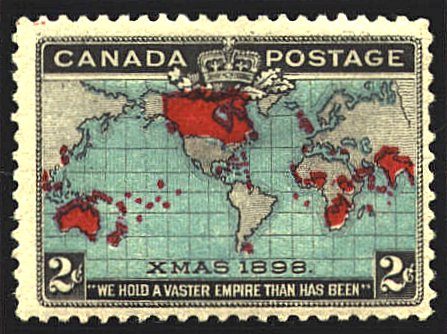|
George R. Parkin published
The British Empire Map of the World on Mercator’s Projection in
1893 to further the cause of imperial unity. Parkin was then perhaps
the most influential advocate of a united British Empire; not
surprisingly, his map was a crystallization of the perceived physical
and geopolitical unity of the Empire onto a single sheet. By the
conscious choice of size, projection, and coloring, and by the
judicious marking of naval and coaling bases, railways and telegraph
and steamer routes, Parkin attempted to demonstrate the reconstruction
of the world which modern technology had produced and which in turn
had made the scattered British Empire an organic unity.
In 1898 in
anticipation of the imperial penny post, the Canadian Postmaster
General, Sir William Mulock, consulted Parkin for a suitable subject
for a stamp intended to emphasize the unity of the Empire, and
accepted his recommendation of the map as an appropriate subject.
Parkin told a friend, “It will be a miniature reproduction of my map
of the empire with Canada in the centre, with a strong Imperial Motto,
and various other Imperial embellishments.” The motto “We Hold a
Vaster Empire Than Has Been” is from a poem by Sir Lew Morris, 1887.

The red color indicates parts of the British Empire. However, the
empire it indicates is "vaster" than reality. German South Africa,
Portuguese East Africa and the Republics of Transvaal and the Orange
Free State, and Borneo are colored red, but were not British.
The
Cartophilatelist, 34(1989)55.

In
1998, 100 years after The Map Stamp was issued, that occasion was
commemorated by the issuing of a stamp-on-stamp of The Map Stamp.

 
 |
